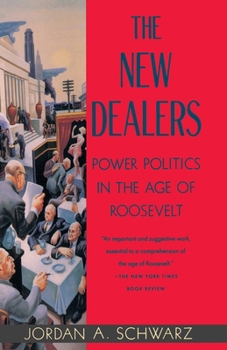The New Dealers: Power Politics in the Age of Roosevelt
Select Format
Select Condition 
Book Overview
This bold new analysis of the New Deal dramatically revises our vision of the Roosevelt legacy -- and of the new relation between government and business it made a central fact of American life. With impressive scholarship and narrative brio, Jordan A. Schwarz persuasively demonstrates that the New Deal's architects sought not merely to save an endangered American capitalism but to integrate economically underdeveloped regions of the nation within the scope of a dynamic state capitalism capable, after World War II, of dominating the global marketplace. As he assesses the contributions of such figures as Supreme Court Justice Louis D. Brandeis, the legal and political "fixer" Thomas G. Corcoran, Texas legislators, Sam Rayburn and Lyndon Johnson, and the quintessential New Deal industrialist Henry Kaiser, Schwarz produces a volume that should be required reading for anyone concerned with current American industrial policy. And he does so with a liveliness and depth of insight that make The New Dealers comparable to the best work of Arthur Schlesinger or Robert Caro.
Format:Paperback
Language:English
ISBN:0679747818
ISBN13:9780679747819
Release Date:April 1994
Publisher:Knopf Doubleday Publishing Group
Length:432 Pages
Weight:0.85 lbs.
Dimensions:1.0" x 5.2" x 8.0"
Customer Reviews
1 rating
Public Investment and Those who Made it Happen: an Important Aspect of the New Deal
Published by Thriftbooks.com User , 18 years ago
Franklin Roosevelt is considered by many historians of the American West to be the most important president for western USA, because FDR's massive public investments in energy, water, and credit greatly developed the infrastructure of the region and made the region more viable for private economic investment. Massive investments were also made in the Pacific Northwest, parts of the South, and other areas. These investments helped fuel the decades of booming economic expansion that followed - the great post-war boom. Examples of these investments include the Norris Dam, Humboldt River Aqueduct, Los Angeles Aqueduct, Bonneville Navigation Dam, Grand Coulee Dam, Pocatello Reservoir, All American Irrigation Canal, Wyoming Drought Canal, Houston Ship Canal, Denver Water Tunnel, Nebraska Power Project, Fort Peck Dam, Mississippi erosion Mattress, and 26 Dams and Locks on the St. Louis-Minneapolis Waterway. Thousands of schools, bridges and tunnels were also built - too many to list. This book profiles the New Dealers who worked to further the economic developments of their areas of interest. Some profiles are more interesting than others. A stronger overall history weaved throughout would have made the book even better. Big investments in the infrastructure were made. Other kinds of investments made too. FDR's GI Bill also made a huge investment in America's human capital. Thousands of Americans were able to attend college for the first time. This helped greatly expand the middle class and helped lead to the great post-war boom. FDR brought electricity to hundreds of thousands of people who had no electricity before FDR became president. Huge amounts of credit also were extended to regions to foster development. Decades of booming, stable prosperity followed - the great post-war boom. A great book on the economic history of America, to put these investments in context, is John Gordon Steele's "An Empire of Wealth." There had been other big investments previously in American history but not on this broad of a scale and usually only for the Northeast. So much emphasis has been placed on Roosevelt's Great Depression relief programs and Social Security - his basic welfare state (later expanded by subsequent presidents and Congress) - that the New Deal's long-term economic achievements often get overlooked. In addition, FDR's economic stabilizers created lasting economic stability and prevented another depression. These reforms included the SEC to police financial markets, FDIC to end bank runs and save the banking industry, Federal Reserve Open Market Committee to control the money supply, and other regulatory agencies to prevent detrimental economic behavior, etc. Prior to FDR, there had been several depressions in American history. After FDR, a depression never happened again. Decades of booming, stable prosperity followed - the post-war boom. The New York Times review of this book, by Alonzo Hamby, said that the idea of New Deal investment in th





